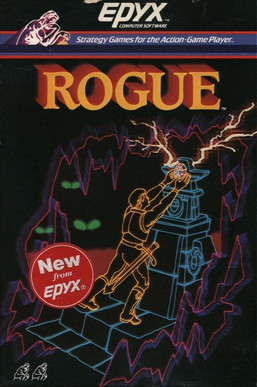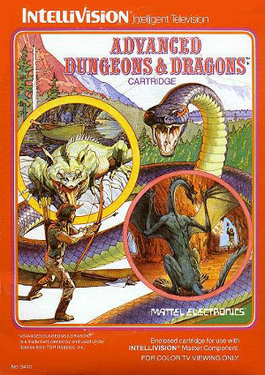
Roguelike is a subgenre of role-playing computer games traditionally characterized by a dungeon crawl through procedurally generated levels, turn-based gameplay, grid-based movement, and permanent death of the player character. Most roguelikes are based on a high fantasy narrative, reflecting their influence from tabletop role playing games such as Dungeons & Dragons.
Rolemaster is a tabletop role-playing game published by Iron Crown Enterprises since 1980.

Rogue is a dungeon crawling video game by Michael Toy and Glenn Wichman with later contributions by Ken Arnold. Rogue was originally developed around 1980 for Unix-based minicomputer systems as a freely distributed executable. It was later included in the Berkeley Software Distribution 4.2 operating system (4.2BSD). Commercial ports of the game for a range of personal computers were made by Toy, Wichman, and Jon Lane under the company A.I. Design and financially supported by the Epyx software publishers. Additional ports to modern systems have been made since by other parties using the game's now-open source code.

HeroQuest, sometimes written as Hero Quest, is an adventure board game created by Milton Bradley in conjunction with the British company Games Workshop. The game was loosely based around archetypes of fantasy role-playing games: the game itself was actually a game system, allowing the gamemaster to create dungeons of their own design using the provided game board, tiles, furnishings and figures. The game manual describes Morcar/Zargon as a former apprentice of Mentor, and the parchment text is read aloud from Mentor's perspective. Several expansions were released, each adding new tiles, traps, artifacts, and monsters to the core system.

Citadel is a computer game developed by Michael Jakobsen for the BBC Micro, and released by Superior Software in 1985. It was also ported to the Acorn Electron. Centred around a castle, this platform game with some puzzle-solving elements requires players to find five hidden crystals and return them to their rightful place. It also features some outside areas external to the castle.

Odyssey: The Compleat Apventure was a video game written by Robert Clardy and released by Synergistic Software in 1980. It was created for the Apple II platform and is considered one of the first microcomputer-based role-playing video games. The title was intentionally misspelled; Apventure is a reference to the Apple computer while "Compleat" is simply an Archaic spelling of the word "complete" meant to match the feel and setting of the game.

Wizards & Warriors, titled Densetsu no Kishi Elrond in Japan, is an action platform video game developed by Rare and published by Acclaim Entertainment and Jaleco for the Nintendo Entertainment System. It was released in North America in December 1987, and in Europe on January 7, 1990. The player controls Kuros, "Knight Warrior of the Books of Excalibur", as he sets out in the Kingdom of Elrond to defeat the evil wizard Malkil. Malkil holds the princess of Elrond captive in Castle IronSpire, deep within the forests of Elrond. The player fights through forests, tunnels, and caves, while collecting keys, treasure, weapons, and magic items.

King's Quest III: To Heir Is Human is the third installment in the King's Quest series of graphic adventure games developed and released by Sierra On-Line in 1986. The game was originally released for the Apple II and PC DOS, and later ported to several other computer systems. It was the first title game in the series not to feature King Graham as the player character.

Might and Magic VIII: Day of the Destroyer is a role-playing video game developed for Microsoft Windows by New World Computing and released in 2000 by The 3DO Company. It is the eighth game in the Might and Magic series. The game received middling critical reviews, a first for the series, with several critics citing the game's length and its increasingly dated game engine, which had been left fundamentally unaltered since Might and Magic VI: The Mandate of Heaven in 1998. The game was later ported to PlayStation 2 in Japan and published by Imagineer on September 6, 2001.

Secret of the Silver Blades is the third in a four-part series of Forgotten Realms Dungeons & Dragons "Gold Box" adventure role-playing video games. The game was released in 1990.

Dofus is a tactical turn-based massively multiplayer online role-playing game (MMORPG) developed and published by Ankama Games, a French computer game manufacturer. Originally released solely in French, it has since been translated into many other languages. The game includes both pay-to-play accounts offering the full experience and free-to-play accounts offering a more limited amount of content. Its success has led to the marketing of spin-off products, such as books, art, comics and a movie released in 2016. It has also led to the development of two continuations: Dofus Arena, released at the beginning of 2006, which is an alternative "tournament" version of Dofus; and Wakfu, a sequel to Dofus. The game has attracted over 40 million players worldwide and is especially well known in France.

pedit5, alternately called The Dungeon, is a 1975 dungeon crawl role-playing video game developed for the University of Illinois Urbana-Champaign's PLATO computer network by Rusty Rutherford. In it, the player controls a character exploring a fixed, single-level dungeon containing randomly-generated monster encounters and treasure. When they encounter a monster, they can fight the monster with a weapon or spells, or attempt to flee. Characters can be saved between sessions.

Advanced Dungeons & Dragons: Treasure of Tarmin is a video game for the Intellivision video game console and the Mattel Aquarius computer system. This game was a licensed Dungeons & Dragons adaptation.

Advanced Dungeons & Dragons is an Intellivision game; it was one of the first Advanced Dungeons & Dragons games to be licensed by TSR, Inc. It was later retitled to Advanced Dungeons & Dragons: Cloudy Mountain to distinguish it from the sequel, Advanced Dungeons & Dragons: Treasure of Tarmin. It is the first Intellivision cartridge to use more than 4K of ROM.

Imogen is a computer game released in 1986 for the BBC Micro. It was written by Michael St Aubyn and published by Micro Power. It was reissued as the lead game of Superior Software / Acornsoft's Play It Again Sam 5 compilation in 1988 when it was also converted for the Acorn Electron. It is a platform game featuring puzzles.

Telengard is a 1982 role-playing dungeon crawler video game developed by Daniel Lawrence and published by Avalon Hill. The player explores a dungeon, fights monsters with magic, and avoids traps in real-time without any set mission other than surviving. Lawrence first wrote the game as DND, a 1976 version of Dungeons & Dragons for the DECsystem-10 mainframe computer. He continued to develop DND at Purdue University as a hobby, rewrote the game for the Commodore PET 2001 after 1978, and ported it to Apple II+, TRS-80, and Atari 800 platforms before Avalon Hill found the game at a convention and licensed it for distribution. Its Commodore 64 release was the most popular. Reviewers noted Telengard's similarity to Dungeons and Dragons. RPG historian Shannon Appelcline noted the game as one of the first professionally produced computer role-playing games, and Gamasutra's Barton considered Telengard consequential in what he deemed "The Silver Age" of computer role-playing games preceding the golden age of the late 1980s. Some of the game's dungeon features, such as altars, fountains, teleportation cubes, and thrones, were adopted by later games such as Tunnels of Doom (1982).
Spectral Associates was an American maker of computer games for the TRS-80 Color Computer. It was founded in 1980 and went defunct sometime in the late 1980s. Spectral Associates sold their software through Radio Shack and via direct sales. It was a very prolific game company for the TRS-80 Color Computer I and II in its heyday.

Valley of the Minotaur is an interactive fiction game for the Apple II, Commodore PET, VIC-20, and Commodore 64 home computers. It was published by Softalk magazine under the Zeuss Scientific label in 1983. Inspired by Greek mythology, the goal of the game is to collect a set of treasures.
Mystery Mansion is the name of a series of board games in which players search furniture and other objects inside a mansion to locate a hidden treasure or stash of money.

The Dungeons & Dragons Computer Labyrinth Game was an electronic board game released by Mattel in 1980.

















